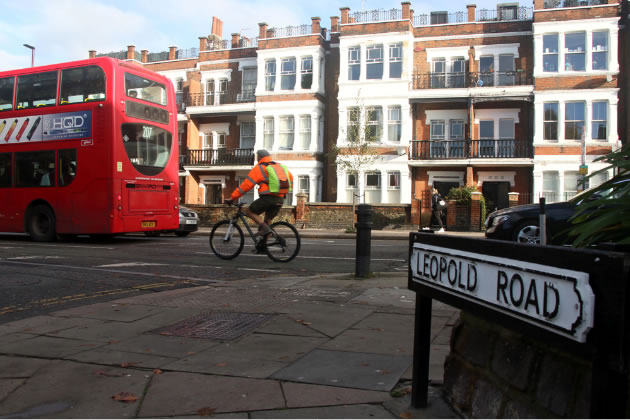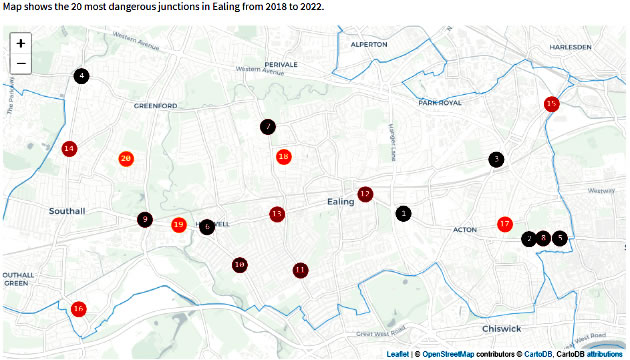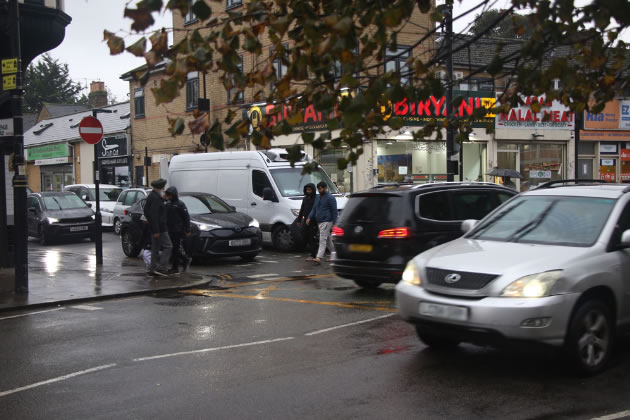New Report Highlights Ealing's Most Dangerous Junctions
Highest number of cyclist injuries occurs at location on Uxbridge Road

The junction of Uxbridge Road with Leopold Road and Wolverton Gardens
|
November 14, 2023
A new report by the London Cycling Campaign (LCC) has mapped the most dangerous junctions for cycling across London.
The good news for bike riders is that no spot in the Ealing area makes the top twenty locations which have seen the highest rate of collisions.
However, the most dangerous junction locally is near Ealing Common Station where the Uxbridge Road meets Leopold Road and Wolverton Gardens. Five cyclists have been seriously injured here and nine slightly injured in the last five years. The main cause of injuries is motorists turning right and colliding with people cycling along the Uxbridge Road.
The campaign has released a new interactive map showing where London's most dangerous junctions for cycling are situated. For the first time, LCC's mapping covers all of London, and can be filtered to find the most dangerous junctions for pedestrians as well as those cycling – and by borough. The map uses the latest, recently released 'Stats19' emergency services response data for 2018-2022.

Map of Ealing Borough's most dangerous junctions
The map shows that the most dangerous junction for people walking in the borough is also the most dangerous location for pedestrians in the whole of London. Two people have been killed in the last five years and two slightly injured on Southall High Street near Avenue Road.

The junction of Southall High Street and Avenue Road is the most dangerous for pedestrians
Ealing Cycling Campaign is calling on Ealing Council to carry out a safety audit on both these junctions, and make the necessary changes to improve safety. These junctions are important not only as part of the A4020 Uxbridge Road which is used by many east-west cyclists, but also as crossing points over the A4020 used by north-south cyclists who are trying to use quieter roads. Both junctions are included in the proposed future Ealing Cycling Network which ECC are urging the council to improve.
Top Twenty Most Dangerous Junctions in Ealing Borough
| Rank | Location | Danger Metric | Cyclist collisions | ||
|---|---|---|---|---|---|
| Fatal | Serious | Slight | |||
1 |
Leopold Rd-Wolverton Gdns-Uxbridge Rd |
4.2 |
0 |
5 |
9 |
2 |
Warple Way-East Acton Lane-The Vale |
2.1 |
0 |
2 |
2 |
3 |
Horn Lane-Noel Rd |
2.1 |
0 |
2 |
2 |
4 |
Lady Margaret Rd-Kensington Rd-Ruislip Rd |
2.0 |
0 |
2 |
3 |
5 |
Third Ave-The Vale |
1.9 |
0 |
2 |
4 |
6 |
Westminster Rd-Uxbridge Rd |
1.8 |
0 |
2 |
0 |
7 |
Argyle Rd-Vallis Way-Scotch Common |
1.7 |
0 |
2 |
1 |
8 |
Larden Rd-The Vale |
1.1 |
0 |
1 |
3 |
9 |
Uxbridge Rd-Greenford Rd |
1.1 |
0 |
1 |
2 |
10 |
Boston Rd-Elthorne Park Rd |
1.1 |
0 |
1 |
1 |
11 |
Green Ave-Northfield Ave |
1.1 |
0 |
1 |
1 |
12 |
The Mall-Hamilton Rd-Northcote Ave-Uxbridge Rd |
1.1 |
0 |
1 |
1 |
13 |
Broadway-Leeland Terrace |
1 |
0 |
1 |
2 |
14 |
Somerset Rd-Lady Margaret Rd-Lynwood Gdns |
1 |
0 |
1 |
1 |
15 |
Victoria Rd-Old Oak Common Lane-Old Oak Lane |
1 |
0 |
1 |
1 |
16 |
Thorncliffe Rd-Norwood Rd |
1 |
0 |
1 |
1 |
17 |
Churchfield Rd-East Churchfield Rd |
1 |
0 |
1 |
0 |
18 |
St Stephen's Ave-1 |
1 |
0 |
1 |
0 |
19 |
Wharncliffe Drive-Uxbridge Rd |
1 |
0 |
1 |
0 |
20 |
Prince's Ave-King's Ave-Queen's Ave |
1 |
0 |
1 |
0 |
Junctions and crossing points are where a significant proportion of serious and fatal collisions happen in London and in general. The LCC says that junction design has long been understood to be one of the key methods of not only reducing road danger but also enabling more people to walk and cycle comfortably and safely.
LCC's map has been a year in development to use an algorithm that treats nearby junctions as 'clusters' (so larger gyratories, or complex multi-junction systems show up), uses five years of emergency services data for 'slight', 'serious' and 'fatal' collisions weighted by DfT 'value' factors, and weights newer collisions higher so junctions where traffic patterns have changed or improvements have been made are progressively downweighted, and factors in multi-victim collisions too.
The most dangerous junction for cyclists in the capital is in Tooting where Cycle 'SuperHighway' CS7 is intersected by a number of side roads. CS7 at this point is 'wand' protected cycle tracks but the LCC says both wand placement and side road treatments are poor and that the lack of treatment of the 'ratruns' with LTNs is the big issue. 29 cyclists have been injured at this junction over five years, 11 of them seriously.
Tom Fyans, Chief Executive of LCC says, "Behind this horrific data are hundreds of stories of families torn apart by tragedy and lives changed forever. The Mayor has committed to a 'Vision Zero' of London by 2041 – but that would mean over 17 years more fatal and serious collisions for Londoners. Whilst cycling and indeed walking and wheeling remain relatively safe, healthy ways of getting about London, TfL, the Mayor and our boroughs must move faster and be bolder on road danger to stem the human cost posed by dangerous junctions and poor road designs,"
Like Reading Articles Like This? Help Us Produce More This site remains committed to providing local community news and public interest journalism. Articles such as the one above are integral to what we do. We aim to feature as much as possible on local societies, charities based in the area, fundraising efforts by residents, community-based initiatives and even helping people find missing pets. We've always done that and won't be changing, in fact we'd like to do more. However, the readership that these stories generates is often below that needed to cover the cost of producing them. Our financial resources are limited and the local media environment is intensely competitive so there is a constraint on what we can do. We are therefore asking our readers to consider offering financial support to these efforts. Any money given will help support community and public interest news and the expansion of our coverage in this area. A suggested monthly payment is £8 but we would be grateful for any amount for instance if you think this site offers the equivalent value of a subscription to a daily printed newspaper you may wish to consider £20 per month. If neither of these amounts is suitable for you then contact info@neighbournet.com and we can set up an alternative. All payments are made through a secure web site. One-off donations are also appreciated. Choose The Amount You Wish To Contribute. If you do support us in this way we'd be interested to hear what kind of articles you would like to see more of on the site – send your suggestions to the editor. For businesses we offer the chance to be a corporate sponsor of community content on the site. For £30 plus VAT per month you will be the designated sponsor of at least one article a month with your logo appearing if supplied. If there is a specific community group or initiative you'd like to support we can make sure your sponsorship is featured on related content for a one off payment of £50 plus VAT. All payments are made through a secure web site. |